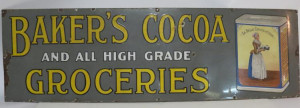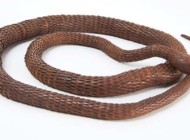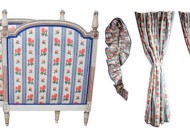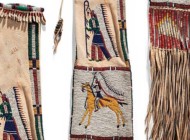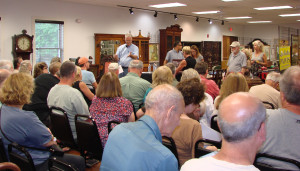
John White sells the first lot in their new building. It was a 42-piece Gorham sterling flatware service in the Celeste pattern and it brought $719.
Review by Rick Russack, Photos Courtesy of White’s Auctions
MIDDLEBORO, MASS. — John White and his wife, Kathryn Black, have been in the auction business for 23 years, doing business as White’s Antique Auctions. After renting space in a variety of locations, they moved into the building they now own and the salesroom was full for their June 28 sale, the first in this new venue. They had remodeled the building into a first-class auction hall. Aside from minor tweaks to the sound system, all went well and the sale proceeded quickly and smoothly. Nearly 300 lots were offered and internet bidding, as well as phone bids were accepted, and several absentee bids had been left. After the sale, both principals said that the new facility had worked well.
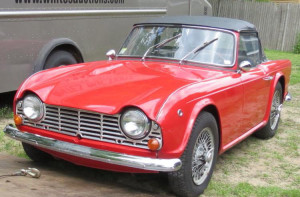
Parked in front of the auction building, this 1964 Triumph TR4 convertible created a lot of interest. It was bright red, with a black leather interior and 64,000 original miles. A buyer in the back of the room paid $8,913 for it.
The business grew from a small antique shop in Middleboro run by White. He met Black, who was running an interior design business in town. They liked each other, became business partners and eventually married. When they decided to try running auctions, they got a book from the library to see how others were doing it and conducted their first auction from the small antique shop, with the crowd overflowing onto the sidewalk. That first sale, in 1993, was a success and included a painting by Hudson River School artist Alfred Bircher, which sold for $67,000.
They conduct six to eight auctions a year, and for their 20th anniversary sale in June 2013, sold a Western painting by Herbert Dunton for $138,000. They got it from a home in the Concord, Mass., area, where its owners thought it was a print.
This summer sale included coins and currency, musical instruments, furniture, a 1964 Triumph convertible, toys, maps, trade signs, paintings, jewelry and more. The item bringing the highest price surprised most in the hall, including the auctioneer, as it sold for 11 times over estimate. It was a carved and painted stern board, more than 10 feet wide, in the form of a spread-winged eagle holding a shield of red, white and blue. It was well carved, with good detail to the eagle’s head and wings. Estimated at a mere $700/900, it achieved $10,350.
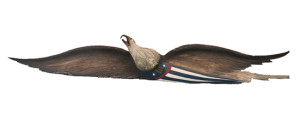
The top grossing lot of the sale was this well carved stern board, more than 10 feet long. It came from Kingston, Mass., and sold for 11 times its estimate, finishing at $10,350.
A second surprise of the evening was a cast iron, side mounted US mailbox, circa 1880–900. In original blue and red paint, it had been made by the Orr, Painter & Co., Carlisle, Penn. With an embossed eagle and “US Mail” in raised lettering, it was estimated at $500, but finished at $1,552.
The 1964 Triumph TR4 convertible was one of the crowd favorites. Bright red, with a black leather interior, it was parked in front of the auction hall and was the subject of much discussion. It had just over 64,000 original miles and been repainted in 1994. Only about 40,000 TR4s were manufactured over their production run of less than four years. Famous Italian designer Giovanni Michelotti was responsible for the new look of the car when it was introduced, and, in addition to its modern styling, it also had success on the race track. A bidder in the room paid $8,912.
A painting by Harold Newton (American, 1934–1964), one of the original Florida Highwaymen, brought $2,760. The Florida Highwaymen were a group of 26 African American painters active from the 1950s through the 1980s. They were self-taught artists painting scenes of the Sunshine State’s landscapes. Many of the scenes they painted have since been altered as the tourism industry developed. The Highwaymen were unable to sell their works through established galleries and so made their living selling door-to-door to businesses and individuals throughout Florida. They also sold their work from the trunks of their cars, traveling along the Eastern Seaboard.
Today, Newton is considered the most talented painter of the group and is the subject of a book by Gary Monroe, Harold Newton: The Original Highwayman. This painting may have been a good buy as Newton’s work has often sold in the five figures.
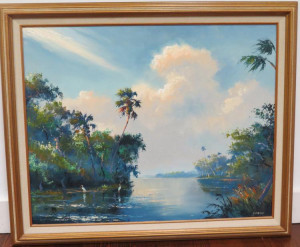
The Florida Highwaymen were a group of self-taught African American artists, working in the Sunshine State. Harold Newton was, perhaps, the best painter of the group and this landscape may have been a good buy, bringing $2,760.
The sale included other good paintings and a Seventeenth Century map of America. A circa 1872 portrait of the ship Louise, out of Liverpool, by William Howard Yorke (British, 1847–1921) sold for $5,060. A well-done painting of Peter Bent Brigham, seated upon a horse, with documentation from the Vose Gallery, sold under estimate, going out at $719. Brigham’s endowment established the well-known Boston hospital bearing his name.
John Speed’s map, The Description of America, cataloged as circa 1676 but probably published later, reached $2,875. Speed’s map showed California as an island and had considerable detail of the East Coast. The representation of California as an island persisted for several years, and has added to the map’s interest to collectors. Along the top border were depictions of eight American cities, as well as Indians.
Coins and currency sold well, much of it to one buyer. Setting the tone early in the sale was a group of 14 Edward VII gold sovereigns. They were dated 1904–1925 and the combined lot weighed 77.88 pennyweight. They sold for $4,945. An 1899 Black Eagle $1 “blanket” note, with Lincoln and Grant portraits, in fine condition realized $633, while a 1922 $20 gold certificate, with a portrait of Washington, reached $288. Gold certificate notes, such as this one, were once redeemable in gold and clearly state “Twenty Dollars in Gold Coin Payable to the Bearer on Demand.”
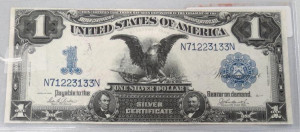
The sale included several pieces of American currency. This large $1 “blanket” note, circa 1899, went for $633. It had engraved portraits of Lincoln and Grant.
A scarce 1914 $1 Federal Reserve bank note brought $403. Most of these notes have been redeemed and according to the Treasury Department, only about $2 million are still outstanding from an issue of nearly $762 million.
A group of Twentieth Century band instruments created interest in several bidders. A Miraphone brass tuba in its original case went for $2,645 to a phone bidder and a silver-plated Sousaphone tuba, also with its case, was claimed by a bidder in the room for $1,323. A circa 1928 Paramount Leader tenor banjo, with mother of pearl inlay on the neck, sold for $460.
Results for furniture were weak. A George Nelson/Herman Miller Action office conference desk, with a polished walnut top on a polished aluminum base, circa 1964, fetched $288. A Victorian walnut cylinder secretary, with burled walnut drawer fronts and a top with glass doors, certainly seemed a good buy, bringing only $230. An Art Nouveau walnut armoire, with double mirrored doors, circa 1900, brought $460.
Enameled trade signs did well. One with local interest, a Baker’s Cocoa example from the Nineteenth Century, garnered $1,265. Baker’s was located in Milton Lower Falls, near Boston, and several local collectors are interested in Baker’s memorabilia. A red, white and blue sign, circa 1920, for Robin Hood flour achieved $196 and a “Pause…Drink Coca Cola” painted building sign earned $518.
Those interested in folk music would have liked the lot with three programs from the Newport Folk festivals of 1965, 1966 and 1968. Each had autographs of several performers, such as Joni Mitchell and Gordon Lightfoot and each included biographies of performers, including Bob Dylan, Joan Baez and Peter, Paul and Mary. Each program had at least 44 pages and the group seemed reasonable at $230.
All prices reported include the buyer’s premium.
For additional information, www.whitesauctions.com or 508-947-9281.
[slideshow_deploy id=’1000271097′]

